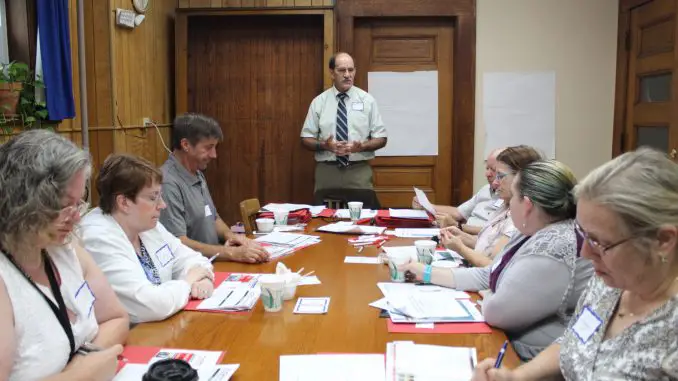
FULTON – Some citizens of Oswego County met with two representatives of New York StateWide Senior Action Council, Inc. today, August 27, as part of a forum on accessing healthcare in CNY.
The forum, held in the Fulton Public Library community room, was one of eight going on across eight counties that same day, all with the same goal: to discuss the barriers and challenges people in New York, specifically CNY, face regarding health insurance.
Marcus Harazin, coordinator of the Patient Advocate Program, and Bob Sinacore, treasurer on the board of directors for StateWide, travelled from the Capital Region to meet and talk with people from Oswego County to hear their stories and ideas for solutions in the health insurance industry.
“We’re doing a fairly good job in Central and Western New York in terms of getting people access to care, but there’s a persistent group, and they call it the 5%, that are uninsured,” Harazin said. “Many folks who could take advantage of programs under Medicaid, programs like Child Health Plus and some the Affordable Care Act benefit programs, like tax credits, aren’t doing it.”
Before discussion on a smaller level, Harazin tuned into a presentation by Peter Newell, the director of the Health Insurance Project for United Hospital Fund. In that presentation, Newell shared statistics and real stories of people who have faced struggles in dealing with health insurance coverage.
Newell conducted a study that found that as a whole, 5.68% of New Yorkers, which is about 1.1 million, do not have health insurance. Included in that number are 2.6%, or 110,745, children under the age of 19.
Although Oswego County has the second-highest poverty rate in CNY – 16.97% (19,121 people) – the study found the county’s uninsured rate is 4.22% (4,793 people), below the state average, and it has the second lowest uninsured rate for children under 19 – 1.27% (318 people).
A large chunk of this can be contributed to loss of Employee-Sponsored Insurance, which covers about 9.6 million people in the state. Or people are eligible, but cannot pay the monthly premiums due to other financial obligations.
Following the presentation, six people living in Oswego County, all with various backgrounds and experiences, joined the discussion on a much more local level.
These people included Catherine Bucher, Mary Vanouse, Mike Falonga, Virginia Bough, Lori Lyon and Stephanie Parrott.
The biggest issues they have faced in regards to health care and coverage were transportation to health care providers who accept their insurance, the insurance company not giving prior authorization for medical needs and access to learning about the right program for their situation.
Falonga, a roofer who has been experiencing issues with his knees, said he had to deal with waiting for the insurance company to approve the plan his doctor came up with.
“It’s been almost a year,” Falonga said. “The insurance company is blaming my union and the union is blaming the insurance company. Just give me a straight answer so I can get back to work. You gotta be healthy to work.”
Lyon had to wait months for her insurance company to approve her to start a medication for diabetes. She said she recently had to get some of her toes amputated from gangrene. As a result of that, she had to wait to get a walker then a cane as she eased back into walking.
She wanted to find a new doctor, but every office she tried either did not accept her insurance, were not accepting new patients or simply rejected her because of the number of her medical issues.
Bucher works at the Oswego Hospital as a case manager. It is her job to help people find a primary care physician.
“It’s really, really difficult because if you have Medicaid, nobody in Oswego is going to take you; the Oswego clinic is closed to new patients; so people living in Oswego have to go as far as Pulaski, sometimes even out of the county,” Bucher said. “The problem for a lot of folks in Oswego County is transportation.”
As for possible solutions, the group had a few ideas to make the situations better. Bucher said CNY needs to attract new doctors to replace the ones who have left the area or retired. She also said there should be more education to the public about the options available to them.
Parrott said there needs to be more consumer protection to make sure people are not being taken advantage of by insurance companies and healthcare facilities.
“They can do what they want and you’re stuck with what they do,” Parrott said.
Following the eight forums, a report will come out with what problems and possible solutions each county discussed.
“All of those organizations are committed to working on these issues, not just to do a report, but to continue to inform folks about it,” Harazin said. “Organizations like StateWide Senior Action have a long history of [advocating for change] and other organizations here are great resources in terms of educating and informing decision makers.”
